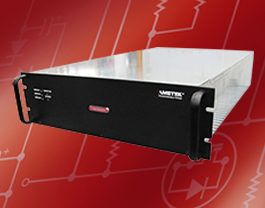The first choice you must make when purchasing a DC power supply for a test system is whether to select a linear supply or switching supply. Linear power supplies offer low ripple and noise specifications and have fast transient behavior. They are, however, inefficient and generate a lot of heat. They are also quite heavy. As a result, most engineers find them desirable only at lower output power levels (typically less then 500 Watts). Most linear DC power supplies are benchtop supplies.
One application for which a linear benchtop supply may be the best choice is when testing sensitive communication devices. To test the true performance of these units, you need to ensure that the DC power supply does not add any parasitic noise to the test setup, and because linear supplies have lower output ripple and noise than switching supplies, they are a better choice for this application.
Linear supplies are also a good choice when power requirements are low. It is often less expensive to use linear DC power supplies in applications that do not require more than 100 W to 200 W per DC output channel. If your test system requires a power supply with four outputs or less, and the power requirements are relatively low, a good solution would be to use four linear supplies in a 19-in. rack-mount kit.
Switchers offer high power density
 The Sorensen ASD Series, with its 3U, 30kW water-cooled packaging, provides the highest power density available.
The Sorensen ASD Series, with its 3U, 30kW water-cooled packaging, provides the highest power density available.
The Sorensen ASD Series is an example of a power supply that provides very high power density. With the ASD series, you can have up to 30 kW of power in a 3U package. The water-cooled packaging allows it to be used in environments that normally exclude air-cooled power supplies.
Even in applications where low ripple and noise output are required, switching supplies may fill the bill. Recent developments in power electronics, such as zero-switching, have dramatically improved the ripple and noise specifications of switching power supplies. When you also consider that switching power supplies are more flexible than linear supplies and provide higher power density, it’s obvious that they are the best choice for all but a handful of applications.
| Advantages | Disadvantages | |
| Linear supply |
|
|
| Switching supply |
|
